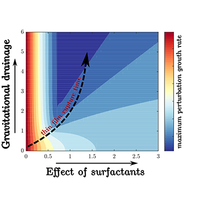含有表面活性剂的排水薄膜的破裂
IF 2.5
3区 物理与天体物理
Q2 PHYSICS, FLUIDS & PLASMAS
引用次数: 0
摘要
在各种工业和生物环境中都会遇到覆盖在固体基底上的含有表面活性剂的液体薄膜。当这些薄膜厚度达到亚微米级时,由于长程分散力的影响,它们往往会变得不稳定。在当前的研究中,我们探讨了重力排水如何影响此类液体薄膜的稳定性属性。我们利用缩放论证证明,重力和分散力可以在很宽的薄膜厚度范围内同时施加影响。在润滑极限下,我们进行了线性稳定性分析和非线性模拟,以了解排水薄膜的演变过程。线性稳定性表明存在两个不稳定模式和两个截止波数,而静止薄膜中只有一个不稳定模式和一个唯一的截止波数。研究还发现,含有表面活性剂的流动薄膜比含有表面活性剂的静止薄膜以及具有清洁界面的排水薄膜更稳定。稳定的原因是由于排水产生的表面活性剂扰动增强。我们证明,表现出中等水平表面活性剂活性和显著排水的薄膜的扰动增长率最低,从而延长了破裂时间。本文章由计算机程序翻译,如有差异,请以英文原文为准。

Rupture of a surfactant-laden draining thin film
Surfactant-laden thin liquid films overlaid on solid substrates are encountered in a variety of industrial and biological settings. As these films reach submicron thickness, they tend to become unstable owing to the influence of long-range dispersion forces. In the current study, we investigate how gravitational drainage affects the stability attributes of such thin liquid films. Using scaling arguments, we demonstrate that gravity and dispersion forces can exert their influence simultaneously over a wide range of film thicknesses. In the lubrication limit, we carry out linear stability analysis and nonlinear simulations to understand the evolution of draining thin films. Linear stability indicates the existence of two unstable modes and two cutoff wave numbers, as opposed to a single unstable mode and a unique cutoff wave number observed in stationary films. It is also found that surfactant-laden flowing films are more stable than stationary films with surfactants as well as draining films with clean interfaces. The origin of stabilization is identified as the enhanced surfactant perturbations generated due to drainage. We demonstrate that films exhibiting intermediate levels of surfactant activity and significant drainage exhibit the lowest rates of disturbance growth, leading to extending the time of rupture.
求助全文
通过发布文献求助,成功后即可免费获取论文全文。
去求助
来源期刊

Physical Review Fluids
Chemical Engineering-Fluid Flow and Transfer Processes
CiteScore
5.10
自引率
11.10%
发文量
488
期刊介绍:
Physical Review Fluids is APS’s newest online-only journal dedicated to publishing innovative research that will significantly advance the fundamental understanding of fluid dynamics. Physical Review Fluids expands the scope of the APS journals to include additional areas of fluid dynamics research, complements the existing Physical Review collection, and maintains the same quality and reputation that authors and subscribers expect from APS. The journal is published with the endorsement of the APS Division of Fluid Dynamics.
 求助内容:
求助内容: 应助结果提醒方式:
应助结果提醒方式:


